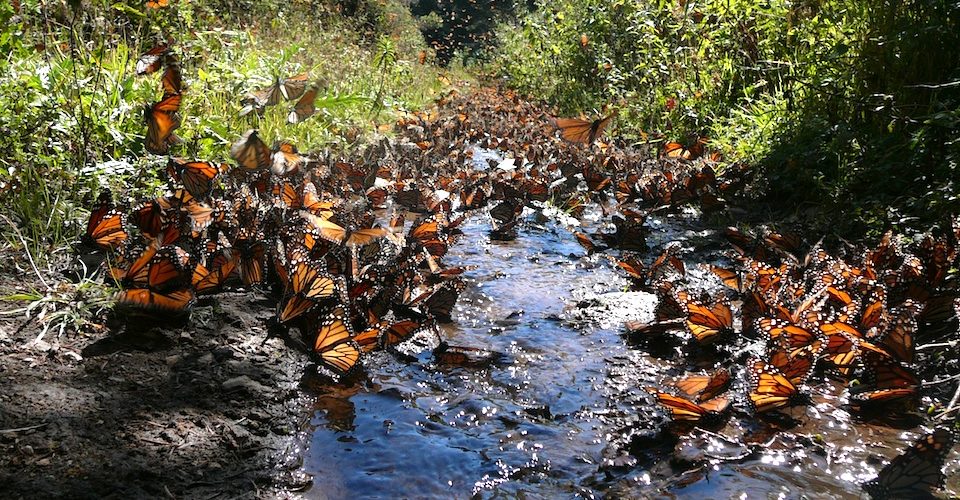Insects are appallingly underrepresented in terms of flagship species, considering they comprise the most diverse group of animals on Earth. While few “bugs” can boast the popularity of lions, tigers and (panda) bears, the flashy Monarch butterfly has been garnering its share of attention of late.
Insects are appallingly underrepresented in terms of flagship species, considering they comprise the most diverse group of animals on Earth. While few “bugs” can boast the popularity of lions, tigers and (panda) bears, the flashy Monarch butterfly has been garnering its share of attention of late.
Unfortunately, the news isn’t good. This year’s survey revealed colonies that spent the winter in Mexico covered only 1.19 hectares – 59 per cent less area than last year and an all-time low since surveying began 20 years ago. Uniquely, this threat concerns a wondrous natural phenomenon – Monarch migration – more than it concerns the species itself; the journey might be history within a decade, while the butterflies will most likely persist.
The population of Monarchs that reside east of the Rockies is renowned for its 2,000-km Tolkienesque trek from Southern Canada to Mexico’s Sierra Madre Mountains each autumn, guided solely by the position of the sun. As far as scientists know, it’s the most highly evolved migration pattern demonstrated by a butterfly or moth and possibly any insect. Indigenous peoples celebrate the Monarchs’ arrival in Mexico’s Oyamel forests, believing the millions of butterflies cloaking the firs house the souls of their ancestors.
Equally impressive is the multigenerational return journey north the following May by butterflies that are descendants of those that flew South before the winter.
Monarch experts have identified several factors imperilling Monarchs and their meanderings:
- Habitat loss due to herbicides. Glyphosate is used widely along migration paths to eliminate milkweeds, which are the only plants that Monarch caterpillars will eat – talk about dining like princesses. Glyphosate also takes out the nectar flowers fed on by adult butterflies.
- Habitat loss due to land conversion. Expansion of farmlands in the US has resulted in the loss of over 120 million acres of habitat since 2007. Urban sprawl is also a main culprit.
- Climate Change. Warm temperatures saw Monarchs arriving in Canada earlier and farther north than normal last year. This was problematic as the milkweed was not yet ready and the hot, arid conditions dried out eggs and reduced the nectar content of flowers. Extreme weather events are expected to increase and impact negatively on the sensitive microclimate where Monarchs overwinter.
- Logging, unregulated ecotourism and declining water availability at overwintering sites. While Mexico has made great progress in protecting its Oyamel forests, logging still occurs and creates “holes” that interfere with the forests’ ability to moderate temperatures within butterfly colonies. Rules governing visitor traffic at the spectacular overwintering sites have reportedly been breached, causing vegetation to be trampled and dust, which can impair butterfly respiration, to be kicked up. Water availability in the Sierra Madres is affected by drought and human usage; these sources are important to arriving Monarchs, who have not stopped to drink since they left Canada.
Zoologist Dr. Lincoln Brower asserts that more detailed research is needed to allow scientists to review and compare the statuses of individual overwintering colonies. “If some are doing better than others, we must learn why. If, as we fear, all are diminishing, then we should ask why the current management plans, both in Mexico and in the United States, are failing.”
I asked Jennifer Tremeer, Education and Interpretive Services Coordinator at the Cambridge Butterfly Conservatory here in Ontario, how Canadians can help bolster Monarch populations. “I would love to see government and corporations lead by example and … use their greenspace to create waystations and habitat for monarchs and other pollinators,” she responded. “Individuals also need to create waystations and register them through Monarch Watch. There are currently only about 250 waystations in all of Canada and we should have thousands!” Waystations are protected patches of milkweeds and nectar flowers that provide food and shelter for Monarchs along their migration routes.
Continued debate over the use of glyphosate and other pesticides is also sure to play a role in the fate of Monarchs and other pollinators. If you missed it, the September/October issue of A\J featured an article by Larry Powell about the Canadian government’s stance on glyphosate.
Want to know more about Monarchs?
- Discover Monarch education, conservation and research at Monarch Watch.
- Learn how to make this year’s garden a Monarch oasis.
- Track Monarch movements and contribute to citizen science at Journey North.
- Pollination Canada has information about Monarchs and how to build a pollinator-friendly garden.
- Watch Dr. Chip Taylor’s lecture on “The Challenges Ahead” for Monarch conservation, presented at the ROM last fall.
- Catch the new IMAX film Flight of the Butterflies 3D, now playing in Gatineau, Edmonton, Montreal and Vancouver.
- Are you a teacher? Check out the Monarch Teacher Network.
- Visit jointheodyssey.org and help support conservation, management and social development in Mexico’s Monarch region.
You can help Monarchs and local agriculture by planting a pollinator-friendly garden this year. Find out more in The Buzz About Pollinators from our Food & Culture blog.
Ellen Jakubowski is a former A\J editorial intern with a BSc in Biology from the University of Guelph and a science communication diploma from Laurentian University. She works as an interpreter at the Cambridge Butterfly Conservatory and blogs about animals in The Wild Side.












